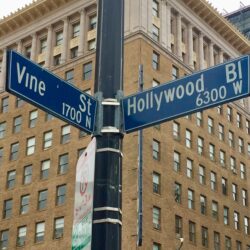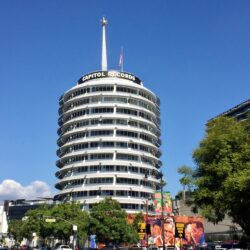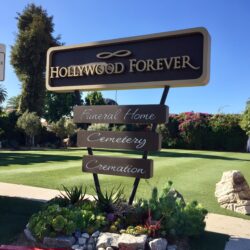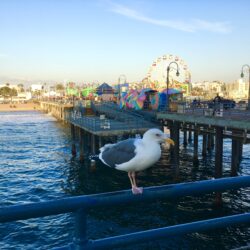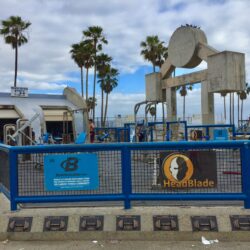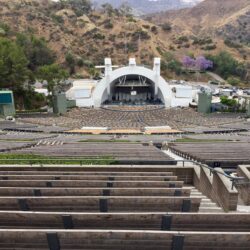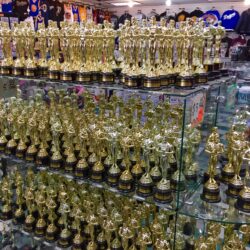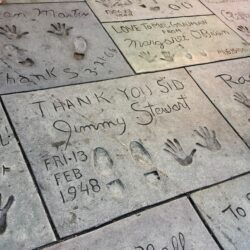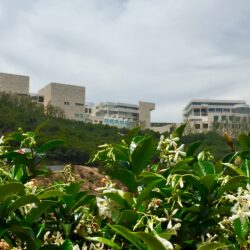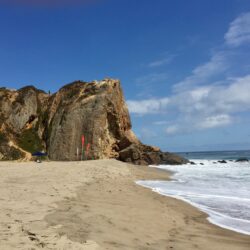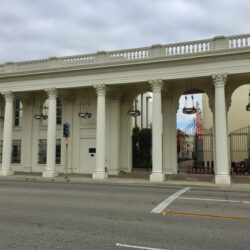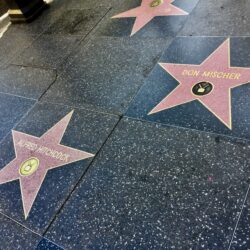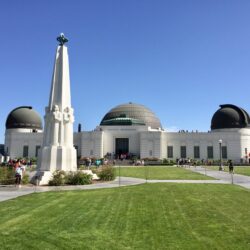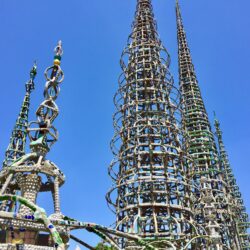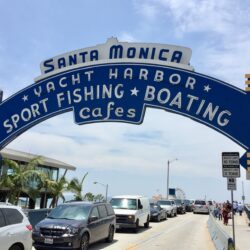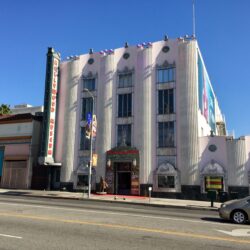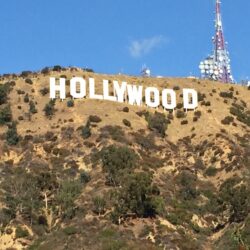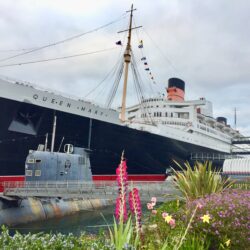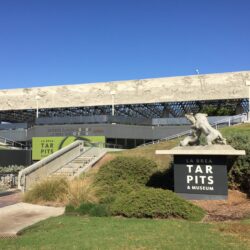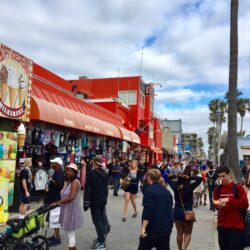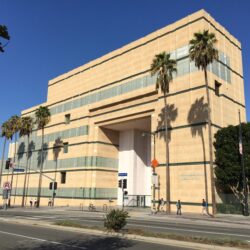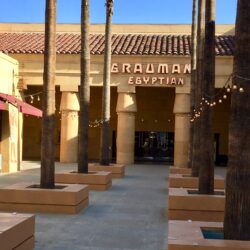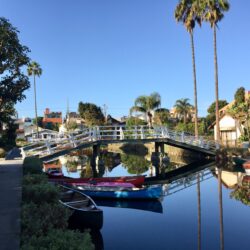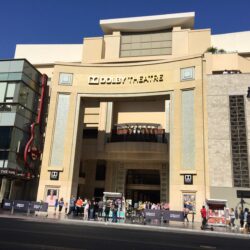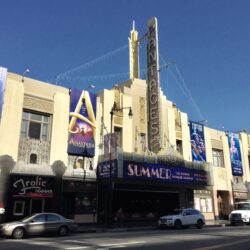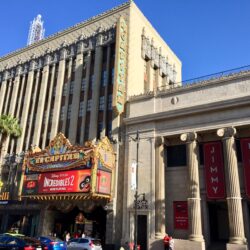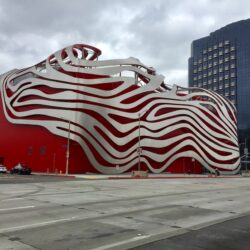A screenwriting class that gives sightseeing advice for Los Angeles too? Yes!
.◊
Some Selected Los Angeles Tourism Suggestions and Tips
Malibu – Featuring Pepperdine University and movie star beach homes (which, for the most part, are hard to see from either the road they’re on or the beach), Malibu is home to Zuma (Public) Beach, one of the widest beaches in the L.A. area and one that usually has good waves. Nearby rocky and cliff-y Point Dume is a great place to hike and take pictures, and ample parking and a trail up to the top are available at Point Dume State Beach, which has its own entrance and is just southeast of Zuma. Malibu is fairly thin in width, with busy Pacific Coast Highway (PCH) (or California State Route 1) running right down the middle of it and the Santa Monica Mountains, with hiking trails winding up and down their ridges and canyons, pressing very near the coast in some places. The shopping/walk-around place is the modern Malibu Country Mart on Cross Creek Road off PCH just west of the Malibu lagoon. On the way to Malibu is the J. Paul Getty Museum’s smaller venue, the Getty Villa, which is a beautiful complex that houses statues, coins, jewelry, and books from ancient Greece and Rome.
Santa Monica pier – Perhaps the best thing about the Santa Monica pier is that, when one goes to visit it, you can park on it. Although, getting a picture of yourself under the entrance sign/arc is a desirable souvenir of the experience, and that would mean a walk back up to Ocean Avenue. The long pier itself features a historic carousel, gift shops, an arcade, and a mini-amusement park complete with small rollercoaster and Ferris wheel. There are restaurants on the pier, but others along Ocean Avenue (or near Ocean Avenue, including those in the downtown Santa Monica Third Street Promenade/outdoor mall) are worth considering too. The scenic-but-thin park along Ocean Avenue north of the pier has made a number of movie appearances and affords great views/photo shots of the pier.
Venice Beach boardwalk – The Venice Beach boardwalk and small park area in between the beach and the boardwalk shops and restaurants have been in so many movies and TV shows that it’s definitely worth taking a stroll down them if you have never done so. Gift and novelty shops abound on the boardwalk. If you want a henna (or real) tattoo, this is the place to get it. Restaurants are mostly cheap eats and funky/unusual fare (for more sophisticated cuisine, try Main Street in south Santa Monica, just north of Venice). The “Muscle Beach” public outdoor weightlifting area is smaller than one might have imagined. The beach is fine, but the south Santa Monica sand just to the north is less crowded.
Venice canals – The most interesting thing about the Venice (CA) canals are the nice homes that line them – that you can (hopefully good-naturedly) covet – as you stroll along the public, sidewalk-like paths that run beside the waterways. There are six canals, and they can be found in between Ocean Avenue and Pacific Avenue a couple of blocks south of Venice Boulevard and 3-4 blocks north of Washington Boulevard. You can drive over them on quaint, humping bridges on Dell Avenue, or walk over them on either Grand Canal (the best walk because it goes over four bridges), Carroll Court (not Avenue), Linnie Avenue, or Howland Avenue. Ducks often abound in the water and on adjacent yards, although not everyone in the neighborhood is thrilled about their loitering and the messes they make. If the canal water level is sagging and algae is blooming, the scenic value of the water itself is underwhelming. It is, however, one of the most unique neighborhoods in Los Angeles.
Studio tours – The typical movie studio tour lasts a couple of hours and consists of walking or riding around with a guide. You get to see “permanent” city street sets and go into a sound stage or two. You’ll get a summary of some of the movie-making steps and elements. You might see a movie or TV star walking around, but that is pretty rare. If there’s a VIP or high-end tour option (at a higher price), it would be a little longer and include a little more information about the movie-making process at some of the stops along the tour – with maybe comments from an expert from that department – plus possibly lunch in the lot restaurant or catered on a sound stage that’s not being used that day. Below is a little more information about the tours that are available. 20th Century Fox and Disney Studios do not offer tours, although 20th Century Fox has indicated that it might in the future.
- Paramount Studios – Except for the (historic but now) rental studios, Sunset Gower, Sunset Bronson, and Raleigh, Paramount is the only movie studio left in Hollywood proper, and the tour there does have a historic feel to it. Highlights include the picturesque Bronson Gate and a look at the former Desilu Television studio headquarters, now part of the Paramount lot. The Hollywood sign is visible from Paramount, and the relatively tight quarters enhance the feel that you’re on a working lot. Paramount is bordered by the Hollywood Forever Cemetery on its backside. The tour includes walking, but could be a mix of walking and some riding.
- Warner Bros. Studios – Here you’ll see lots of outdoor buildings/sets that have appeared in big-ticket movies and a wooded area and small lagoon that have been used on both the silver and small screen. The Warner Bros. lot is quite large, and the tour usually includes a look at an active or archived set or two and some famous props, furniture, and/or vehicles. The tour also includes a stopover at the on-lot Warner Bros. Museum, which is two stories of movie costumes and small props. The Warner Bros. tours department is a big, professional, tourist-focused operation, and the tours utilize electric, oversized, custom tour carts for transportation around the lot.
- Sony Pictures Studios – This is the historic, former MGM studio lot where The Wizard of Oz was filmed. This tour is all-walking, and, with Sony having fewer outdoor sets that either Paramount or Warner Bros., it does feel like a shorter tour. You’ll go into sound stages and probably a TV show set. If you walk up the street about four blocks (to the northeast), you can see the front of Culver Studio’s mansion house administrative building, which was modeled after Mount Vernon. It’s just on the other side of the Culver Hotel in “downtown” Culver City.
- Universal Studios – This is the amusement park ride of Hollywood movie studio tours – because it is an amusement park ride (in trams)! It’s actually part of the Universal Studios theme park. That doesn’t mean it’s not informative, though. The tram briefly winds through dense sound stages and administrative buildings before it gets to some famous outdoor sets and large props from past movies, all mixed in with amusement park staged-attractions of special effects that “threaten” the tram. Admission to the overall theme park is required, and lines for the studio tour can be long (even with a timed ticket for the tram tour).
Seeing a television show taping (really, digital shooting) – This Hollywood experience takes some advance planning. Sitcoms, game shows, and talk shows have live audiences, and you can request tickets to be part of it. Earlier requests stand a better chance of success than last-minute ones, and the most popular shows can be tough to score. At the taping/shooting, you have to arrive early, sometimes with a warm-up staffer/entertainer or audience coach to help kill the first half hour you’re in your seat. Once you get going, there are pauses and the session will last longer – sometimes much longer – than the actual show for sitcoms, and you must remain quiet and still. The audience area in the sound stage is usually underwhelming in its comforts, but instructive on the stark difference between the on- and off-camera portions of a TV or movie set.
Hollywood Forever Cemetery – Off Santa Monica Boulevard and just north (abutting) the Paramount Studios lot and generally open during daylight business hours. Final resting place of Rudolph Valentino, Judy Garland, Fay Wray, Peter Lorre, Cecille B. DeMille, John Huston, Mickey Rooney, Mel Blanc, Bugsey Siegel, and many other artists and personalities, many from early Hollywood or its Golden Age.
Hollywood Boulevard and N. Highland Avenue area
- Hollywood Walk of Fame – Along Hollywood Boulevard in between La Brea Avenue and N. Gower Street, and also along a smaller stretch of Vine Street in between Sunset Boulevard and Yucca Street, there are over 2,600 personal and group stars in the sidewalks in several categories: movies, TV, music, radio, theater, and several oddball categories and special recognitions. “Golden Age” and generally older stars are on Vine Street (the individual Beatles are there, although the group’s star is at the Walk’s western end), and there are lot of relatively younger stars in the sidewalks west of N. Highland.
- Dolby Theater (formerly the Kodak Theater) – Site of the modern Academy Awards and a massive sidewalk red carpet set-up during the awards. When it’s not being used or prepped, you can tour the auditorium.
- Hollywood Museum in the Max Factor building – Houses costumes, props, and some great photographs from Hollywood’s Golden Age. Also a one-of-kind tribute to the origins of modern makeup. The historic building is in a great location to be part of one’s Hollywood-proper experience.
- TCL (Grauman’s) Chinese Theater – For a while, the name here was Mann’s. It’s an IMAX theater for movie releases/runs, and the cement foot- and handprints of stars out front are Hollywood icons. Pretty good photo spot, and there might be knockoff movie characters wandering about.
- Grauman’s Egyptian Theater – Features movie classics and special events, sometimes in conjunction with a film showing. Limited tours are offered to the public.
- El Capitan Theater – Almost directly across from the Dolby Theater’s red carpet area. Current releases play here in a grand palace-type movie theater. The entrance is rather narrow, but the theater itself is almost too wide at its back.
- Novelty museums – There are at least four attractions near Hollywood & Highland that were designed to capitalize on the tourist foot traffic in the area: the somewhat historic Hollywood Wax Museum, Madame Tussauds Hollywood wax museum, Ripley’s Believe It or Not Museum (quirky, but gets decent reviews; kids might get a kick out of it), and the Guinness World Records Museum (perhaps the least wowing of this group). Bundled passes for some of them have been available.
Hollywood and Vine – At one time, this was the epicenter or main crossroads of Hollywood, but today there’s less there to see than at Hollywood and Highland.
Pantages Theater – On Hollywood Boulevard half a block east of Hollywood and Vine; hosts mostly Broadway show productions. The Academy Awards were held there from 1949 – 1959.
Capitol Records building – On Vine Street three-quarters of a block north of Hollywood and Vine. Designed to look (somewhat) like a stack of records on a turntable; has appeared in a number of movies as essentially a symbol of Hollywood.
Hollywood Bowl (and Bowl Museum) – FDR spoke here, and the Beatles, Doors, Jimi Hendrix, and (more recently) Van Morrison played here, and the structure has appeared in a number of movies. The Museum is mostly a Bowl performance Hall of Fame, and its hours are seasonally limited.
Mulholland Drive – Runs across the top of the ridge in between Bel Air, Beverly Hills, and Hollywood and the San Fernando Valley. Stars homes are nearby, but tough (if not impossible) to see from the Drive. A highlight just a mile west of Cahuenga Boulevard West (which runs alongside the Hollywood Freeway/101) is the Jerome C. Daniel Overlook above the Hollywood Bowl, from which one can see the Bowl, downtown L.A., and the Hollywood sign.
Giffith Observatory – Also in lots of movie scenes, this City of Los Angeles facility has a planetarium and offers free telescope looks on clear nights. During the day, the views of downtown, the surrounding hills, and the Hollywood sign are also good.
Hollywood sign – Getting (a few hundred feet) above/behind the sign is a substantial hike, but, if you are a hiker, you devote a day to the task and reach the summit of Mt. Lee, where the sign is. Getting to the actual sign letters themselves from either above or below is not really possible to do due to fences, local ordinances, and dangerously steep terrain just below the sign. To get interestingly close to it (but still below it) in a car, set your cell phone map app to “Lake Hollywood Park” and make your way to Lake Hollywood Drive, which is not too many turns off Cahuenga Boulevard East just north of Cahuenga Pass. From there, head around the back side of scenic Hollywood Reservoir until Lake Hollywood Drive turns into Tahoe Drive, then turn right on Canyon Lake Drive, and then you’ll come to Lake Hollywood Park where everyone parks on either the side of the road. For an even closer view of the sign, walk up Canyon Lake Drive until it becomes Mulholland Highway (not Drive; yes, it’s confusing up there). There’s a decent-sized dirt area there that offers good views of both the sign and (on the other side of the road) the Reservoir, and, if you must get even closer, you can walk up Mulholland Highway another hundred yards or so. Beyond that, it’s not advisable to approach further from below. In your car, you can head back down a different way to reach a point not too far from center of Hollywood by setting your GPS to take you to North Beachwood Drive and Franklin Avenue.
Miracle Mile (Museum Row) Museums
- Los Angeles County Museum of Modern Art (LACMA) – Biggest and most diverse art museum in the western U.S. Rembrandt’s The Raising of Lazarus is a painting highlight. The museum also holds a fair number of ancient, small sculpture objects from around the world.
- Peterson Automotive Museum – Movie-appearance cars, movie stars’ (private) cars, extravagant cars, and classic cars, including some very rare ones. Over 100 vehicles in total. If you’re into cars at all, you can’t miss the Petersen.
- Other Museums – The 2019-launched Academy (of Motion Picture Arts and Science) Museum of Motion Pictures takes up the old May Company building on Miracle Mile; the A+D (Architecture and Design) Museum and smaller Craft and Folk Art Museum are also there.
La Brea Tar Pits and George C. Page Museum – While L.A.’s beaches, palm trees, and mountains can be scenic, the city doesn’t have a lot of natural history landmarks, but the tar pits are an exception. You can walk around the grounds of landmark park and see a few small tar pits, and the Page Museum includes skeletons and models of the animals that became trapped in the tar, like ground sloths, camels, American lions, saber-toothed cats, and mammoths (these are Pleistocene mammals of roughly 15,000 years ago, not the dinosaurs of 100 million years ago.)
Getty Center (of the J. Paul Getty Museum) – “The Getty” in north Brentwood is a quite a complex – just getting to it and walking around the beautiful campus is quite an experience itself. You take a tram from the bottom of the hill up to the complex, which offers pretty good views of west L.A. and Santa Monica. The collection at Brentwood is all western art from the Middle Ages to the eighteenth and nineteenth centuries.
Stars’ homes in Beverly Hills, Bel Air, and Holmby Hills – PIBHR usually doesn’t make book recommendations, but, in this case, one is warranted. The side-of-the-road maps to the stars’ homes might be okay, or they might be confusing and less than precise on location. But The Ultimate Hollywood Tour Book by William A. Gordon is about as good a guide as one can get to movie star home locations. Through no fault of Gordon or any other author, many stars’ homes are hidden for view from the street they’re on, and driveways and numbers associated with them are sometimes hard to find or see when driving by. But some current or deceased stars’ homes are right near the street they’re on (the ones south of Sunset Boulevard or not too far north of Sunset are often in this category, although not always), so star home gazing is usually an activity with an up and down level of satisfaction.
Rodeo Drive in Beverly Hills – Worth a walk down as a sight to see (including Via Rodeo near the south end of the famous shopping strip), although a little underwhelming if you’re not actually going to shop. The Beverly Wilshire hotel at the foot of the strip served as the hotel exterior in Pretty Woman.
Manhattan Beach/Pier – Right in the middle Manhattan Beach and very photogenic (for an L.A.-area pier). It has a mini ocean discovery exhibit inside the pavilion at the end.
Watts Towers – Built by over three decades of work in the early 20th century by Italian immigrant and tile construction worker Sabato “Simon” Rodia and nearly demolished in the late 1950s, the historic site now has its own light rail Metro stop.
Queen Mary (Long Beach) – Now a historic hotel, restaurants, and a museum, the RMS Queen Mary is permanently moored to the western edge of the Port of Long Beach, right across the mouth of the Los Angeles River from downtown Long Beach, which has its own skyline with (medium-sized) skyscrapers.
(Santa) Catalina Island – The quaint town of Avalon, the only real population and commercial center on the island, is worth seeing and perhaps best viewed by riding around on a bike or rented golf cart. The Catalina Casino events center was built with an interior stadium-type ramp by William Wrigley, Jr. of Chicago Cubs (and chewing gum company) ownership fame. Avalon is a good half-day excursion.
Disneyland (Anaheim) – The original Disney “world.” The Disney section and attractions in central Anaheim have greatly expanded since the original days of Walt Disney’s creation, but Disneyland proper retains the iconic Sleeping Beauty Castle and its traditional divisions of Main Street, U.S.A., Frontierland, Adventureland, Fantasyland, and Tomorrowland.
Thinking of taking a trip to Los Angeles, attending a Pen It by Hunter Ridgway screenwriting class, and taking in a few sights? You should do it!


